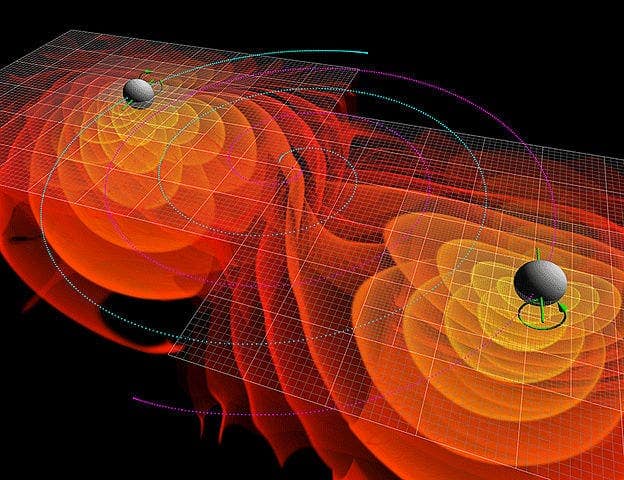It’s pretty much official now: there are gravitational waves. A collaboration between the LIGO Lab and the Virgo interferometer collaboration just reported the first joint detection of gravitational waves, adding much more weight to previous detection events.

Virgo had just been switched on
It’s not the first time gravitational waves had been detected. Physicists had recorded three previous events, offering serious proof to support the hypothesis first proposed by Albert Einstein a hundred years ago. Both the LIGO and Virgo detectors picked up the same event — a binary black hole system colliding. Together, the two observers provided 3D detail of the gravitational warping caused by the collision. To make things even more exciting, this comes just after Virgo had been switched on. It basically observed gravitational waves on its trial run.
“This is just the beginning of observations with the network enabled by Virgo and LIGO working together,” says David Shoemaker of MIT, LSC spokesperson. “With the next observing run planned for Fall 2018 we can expect such detections weekly or even more often.”
“It is wonderful to see a first gravitational-wave signal in our brand new Advanced Virgo detector only two weeks after it officially started taking data,” says Jo van den Brand of Nikhef and VU University Amsterdam, spokesperson of the Virgo collaboration. “That’s a great reward after all the work done in the Advanced Virgo project to upgrade the instrument over the past six years.”
Gravitational waves are basically ripples in the curvature of spacetime, generated in certain gravitational interactions. They propagate as waves outward from their source, at the speed of light. However, in order for us to observe them, we need dramatic interactions between the most massive objects we know of: black holes. Even these dramatic events send only a tiny observable wobble, which require finely tuned detectors, the likes of which only LIGO and Virgo provide. That two facilities, functioning independently, confirmed the same thing is highly encouraging.
“Little more than a year and a half ago, NSF [National Science Foundation] announced that its Laser Gravitational-Wave Observatory had made the first-ever detection of gravitational waves resulting from the collision of two black holes in a galaxy a billion light-years away,” says France Córdova, NSF director. “Today, we are delighted to announce the first discovery made in partnership between the Virgo Gravitational-Wave Observatory and the LIGO Scientific Collaboration, the first time a gravitational-wave detection was observed by these observatories, located thousands of miles apart. This is an exciting milestone in the growing international scientific effort to unlock the extraordinary mysteries of our Universe.”
Thanks to slightly different fine-tuning, the two observers allow researchers to observe different characteristics of the waves. Specifically, Virgo’s arms are angled differently than the two Ligo detectors, which allows it to extract new information about the polarisation of gravitational waves. This is extremely important because previous observations from LIGO came from two detectors with a parallel orientation. Vigo’s arms come at a different angle (an intentional design feature), allowing researchers to get a more 3D view of what’s happening.
“It’s like if I give you just one slice of apple, you can’t guess what the fruit looks like,” said Prof Andreas Freise, a Ligo project scientist at the University of Birmingham. “When you see things from different angles, suddenly you can see the 3D shape as well,” he said. “Einstein’s theory of what [the waves] look like is pretty clear.”
Although Henri Poincaré first suggested that in analogy to an accelerating electrical charge producing electromagnetic waves, gravitational waves are tightly associated to Albert Einstein, who first predicted their existence in 1916, in his famous general theory of relativity. His mathematical equations showed that massive accelerating objects (namely neutron stars or black holes orbiting each other) would disrupt the fabric of space-time, sending waves in the process, much like a stone thrown into a pond sends ripple in the water. However, later on in his work, Einstein started to doubt their existence. In 1936, Einstein and Nathan Rosen submitted a paper to Physical Review in which they argued that the gravitational waves could not exist in the full theory of general relativity. The paper was anonymously reviewed by mathematician Howard P. Robertson, who pointed out some miscalculations within the paper. Furious, Einstein withdrew the paper, but ultimately, one of his assistants, who had been in contact with Robertson, convinced Einstein that the criticism was correct. They rewrote the paper, but with exactly the opposite conclusions, supporting the existence of gravitational waves.



